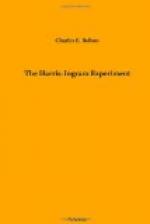George Ingram in his own mind had settled three vital points; that Harrisville was one of the most favorable producing and distributing centers in America; that he would so design and build a manufacturing plant as to minimize the cost of production; that he would attempt to harmonize capital and labor. Important provisions of the Company’s charter were:
ARTICLE III
The capital stock of this Corporation
shall be Five Million Dollars
($5,000,000) to be divided into Five Hundred
Thousand Shares at Ten
Dollars each, fully paid, and non-assessable.
ARTICLE VI
The private property of stockholders shall
be exempt from any and all
debts of this Corporation.
Two thousand of the four thousand acres purchased were set apart for manufacturing purposes. Most of the land sloped gradually, and the surface-water naturally drained into the river. George Ingram’s plans for an enormous steel-plant had been most carefully worked out in detail. Night and day the construction went forward. In eight months the plant was in full operation. He had obtained the latest important labor-saving devices and improved facilities in use throughout America and Europe. The whole was supplemented by the inventions already perfected by his father and himself.
The Harris-Ingram Steel Co. was provided with every modern device that could in any manner contribute economy and rapidity from the time the ores left the ship, till the finished product was loaded for market. All ores and limestone were delivered on a tableland of the same height, and adjacent to a series of several enormous blast-furnaces. The melted iron from the blast-furnaces was tapped into ladles mounted on iron cars, and provided with mechanism for tipping the ladles. The molten iron of the cars was next transferred to improved converters in an adjoining building, constructed entirely of iron. Nearby were the spiegel cupolas. The greatest possible accuracy was thus attainable in delivering definite quantities of molten iron into the converter for a given blow, also of spiegeleisen. This was easily accomplished by standing the ladle cars upon scales.
The metal was cast into ingot moulds, standing upon cars, and then transferred to the mould stripper; afterwards the ingots were weighed and sent to the soaking-pit furnaces. After a “wash heat” the ingots, or blooms, entered the rolls, and were drawn and sized in shape to fill orders from every part of the world.
The marvel at the Harris-Ingram Steel Co.’s mills was that electricity, developed in vast quantities at the coal mines and conveyed on patented copper tubes, furnished all the power, heat, and light used in the entire plant. Electricity hoisted and melted all the ores; it worked Sturtevant fans and blowing engines, which supplied necessary air for cupolas and converters. Electricity furnished all the power requisite to handle innumerable cranes and cars. As easily as a magnet picks up tacks, electricity also handled ingots or finished steel. Five thousand tons of finished steel per day were made and the labor and fuel account had been reduced over one-half.




